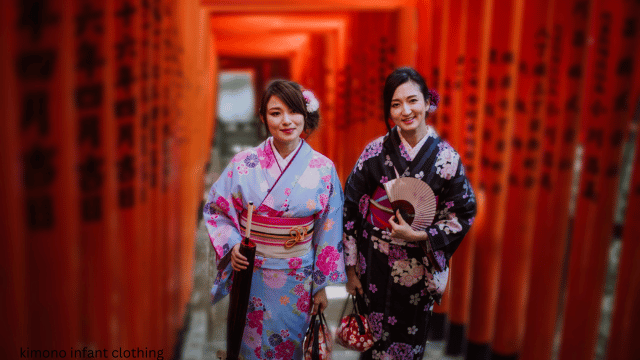As a new parent, I have always been fascinated by the rich cultural heritage and timeless elegance of traditional Japanese attire. When it came to dressing my little one, I knew I wanted to find clothing that not only looked beautiful but also provided comfort and ease of movement. That’s when I discovered the world of kimono infant clothing, and let me tell you, it has been a game-changer.
Kimono infant clothing is more than just a fashion statement; it’s a way to connect your child to the rich tapestry of Japanese culture. These garments, with their intricate designs and soft, natural fabrics, have the power to transport you and your little one to a world of tranquility and beauty.
History and Cultural Significance of Kimono
The kimono has a long and storied history in Japan, dating back centuries. Originally worn by the aristocracy, the kimono evolved over time to become a symbol of Japanese identity and cultural pride. Each design and color holds a deeper meaning, often representing the seasons, natural elements, or important life events.
As I delved deeper into the world of kimono, I was struck by the reverence and care with which these garments are treated. The art of kimono-making is a highly skilled craft, passed down through generations of artisans. From the intricate embroidery to the precise draping and tying techniques, every aspect of a kimono is a testament to the dedication and attention to detail that goes into its creation.
Advantages of Kimono Infant Clothing
When it comes to dressing my little one, comfort and ease of movement are of the utmost importance. That’s where kimono infant clothing truly shines. The loose, flowing silhouette of the kimono allows for unrestricted movement, making it the perfect choice for active babies and toddlers.
Moreover, the natural fabrics used in kimono construction, such as cotton and silk, are gentle on delicate skin and breathe easily, keeping your little one cool and comfortable throughout the day. The wrap-around design of the kimono also makes for easy dressing and undressing, a true lifesaver during those frantic mornings.
But the benefits of kimono infant clothing go beyond just practical considerations. These garments also offer a unique opportunity to immerse your child in the rich cultural heritage of Japan. By dressing your little one in a kimono, you’re not only creating a visually stunning look but also instilling a sense of appreciation for tradition and cultural diversity.
Types of Kimono Infant Clothing
When it comes to kimono infant clothing, there is a diverse range of styles and designs to choose from. From the classic, understated elegance of the basic kimono to the more vibrant and playful designs featuring adorable animal motifs or whimsical patterns, there’s something to suit every taste and preference.
One of the most popular styles is the “baby kimono,” a simplified version of the traditional kimono that is designed specifically for infants and toddlers. These garments often feature a wrap-around design with adjustable closures, making them easy to put on and take off.
Another option is the “yukata,” a lightweight, casual kimono typically worn during the warmer months. Yukata infant clothing is perfect for summer outings, as the breathable fabrics and relaxed silhouette keep your little one cool and comfortable.
For those seeking a more formal look, the “formal kimono” is a stunning choice. These garments feature intricate embroidery, vibrant colors, and elegant patterns that evoke the grandeur of traditional Japanese aristocratic attire. While not as practical for everyday wear, formal kimono infant clothing can be a beautiful choice for special occasions and family celebrations.
How to Choose the Right Size and Style
When it comes to selecting the perfect kimono infant clothing, it’s important to consider both the size and style to ensure a comfortable and flattering fit.
To determine the right size, carefully measure your baby’s height, weight, and chest circumference, and refer to the size charts provided by the manufacturer. Keep in mind that kimono infant clothing is often designed with a more generous fit to allow for easy movement and growth.
In terms of style, consider the occasion and your personal preferences. For everyday wear, a simple, understated baby kimono or yukata may be the most practical choice. For special events or family gatherings, a formal kimono with its ornate details and rich colors can add a touch of elegance and tradition.
It’s also worth considering the climate and season when choosing your kimono infant clothing. Lightweight, breathable fabrics like cotton and linen are ideal for warmer weather, while heavier silks and brocades may be better suited for cooler months.
Tips for Dressing Your Baby in a Kimono
Dressing your little one in a kimono may seem daunting at first, but with a few simple tips, it can be a breeze. Start by laying the kimono flat on a clean, flat surface, with the right side facing up. Gently place your baby on the kimono, aligning their shoulders with the neckline.
Next, wrap the left side of the kimono across your baby’s body, ensuring the fabric is smooth and even. Secure the left side with the appropriate fasteners, such as ties or snaps. Repeat the process with the right side, overlapping it neatly over the left.
To achieve the classic kimono look, use a decorative obi or sash to cinch the waist, creating a beautiful, flowing silhouette. Be sure to adjust the fabric as needed to ensure a comfortable and snug fit, without restricting your baby’s movement.
Remember to take your time and be gentle throughout the process. Dressing your little one in a kimono can be a special bonding moment, so embrace the experience and enjoy the journey.
Care and Maintenance of Kimono Infant Clothing
Proper care and maintenance are essential to keeping your kimono infant clothing looking its best and lasting for years to come. Start by reading the manufacturer’s instructions carefully, as different fabrics and designs may require specific cleaning methods.
In general, most kimono infant clothing can be hand-washed in cold water using a mild detergent. Avoid using hot water or harsh chemicals, as these can damage the delicate fabrics and intricate designs. When drying, lay the garment flat or hang it to air dry, as machine drying can cause shrinkage or distortion.
For more formal or heavily embroidered kimono, it’s best to take them to a professional cleaner who specializes in traditional Japanese garments. They have the expertise and equipment to clean and preserve the intricate details without compromising the integrity of the fabric.
Proper storage is also crucial for maintaining the shape and condition of your kimono infant clothing. Fold the garments neatly and store them in a cool, dry place, away from direct sunlight or moisture. Consider using acid-free tissue paper or muslin bags to provide an extra layer of protection.
By following these simple care and maintenance tips, you can ensure that your kimono infant clothing remains a cherished part of your child’s wardrobe for years to come.
Where to Buy Authentic Kimono Infant Clothing
Finding authentic, high-quality kimono infant clothing can be a bit of a challenge, especially if you’re not located in Japan. However, with a little research and patience, you can discover a wealth of options that will allow you to bring the beauty and tradition of the kimono into your child’s life.
One of the best places to start your search is by exploring online marketplaces and specialty retailers that specialize in Japanese-made clothing and accessories. These vendors often have a curated selection of genuine kimono infant clothing, with a range of styles and designs to choose from.
Another option is to connect with local Japanese cultural centers or community organizations, as they may have connections to artisans and small businesses that sell authentic kimono infant clothing. These local sources can be a great way to support traditional craftsmanship and ensure you’re getting a truly one-of-a-kind piece.
If you’re feeling adventurous, you could even plan a trip to Japan and immerse yourself in the vibrant kimono culture. Visit traditional kimono shops, attend cultural festivals, or explore local markets to discover unique and handcrafted kimono infant clothing that you won’t find anywhere else.
No matter where you choose to shop, be sure to do your research, ask questions, and look for reputable sellers who can provide information about the origins and craftsmanship of the garments. With a little effort, you’ll be able to find the perfect kimono infant clothing to cherish and pass down for generations to come.
DIY Ideas and Customization Options for Kimono Infant Clothing
If you’re feeling creative and want to add a personal touch to your kimono infant clothing, there are plenty of DIY ideas and customization options to explore. From simple embellishments to more elaborate alterations, the possibilities are endless.
One easy way to customize your kimono infant clothing is by adding decorative elements like patches, appliques, or embroidered designs. You can find a wide range of pre-made options online or even create your own custom designs using fabric paints, markers, or iron-on transfers.
For a more hands-on approach, you could try your hand at sewing and create your own kimono-inspired garments from scratch. With a few basic sewing skills and some high-quality fabrics, you can design and construct unique pieces that reflect your child’s personality and your family’s style.
If you’re feeling particularly ambitious, you could even explore the art of kimono-making itself, learning traditional techniques like hand-stitching, pleating, and obi-tying. While this may require a significant investment of time and effort, the end result can be a truly one-of-a-kind treasure that your child will cherish for years to come.
No matter which route you choose, the key is to have fun and embrace the creative process. Customizing your kimono infant clothing can be a rewarding and meaningful way to connect with your child’s cultural heritage while also expressing your own unique style.
Conclusion:
As I reflect on my journey of discovering the world of kimono infant clothing, I am filled with a deep appreciation for the rich cultural heritage and timeless elegance that these garments represent. From the intricate designs to the luxurious fabrics, every aspect of a kimono speaks to the dedication and craftsmanship of the artisans who create them.
But beyond the visual appeal, what truly captivates me is the way in which kimono infant clothing can foster a sense of connection and cultural understanding for my little one. By dressing my child in these beautiful garments, I am not only creating a stunning look but also introducing them to the vibrant tapestry of Japanese tradition and history.











